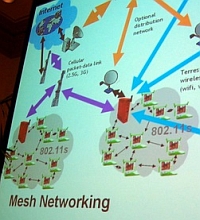So far the OLPC Wiki is in agreement that One Server Per School will facilitate Internet connectivity and have data storage for 100 Children's Machine XO's. Everything else is still up for debate: server hardware & OS, other services, and the actual Internet connectivity method.
No matter what the outcome, the servers will not be free or few. The OLPC Wiki shows the OSPS impact for Argentina:
Doing some quick math based on Argentina Statistics, at the national level you have 5,151,856 kids in K-12 grades in 27,888 public schools, giving ~180 laptops / school (or ~3 servers / school).Or 8,3664 servers total. Now while the final cost for the servers is still unknown, an OLPC feel-good pricing guesstimate would be $200 each or an additional $16.7 million dollars of Argentinean debt financing for one server per school.
Interestingly enough, we do know who will be making the first 50,000 OSPS's. In November, Guilherme Felitti reported (via Google Translate):
The intense participation of the Brazilian government in the project made with that the OLPC chose Brazil to manufacture the servers who will be distributed to the participant schools of the project in the whole world.That would be 50,000 servers manufactured by the Brazilian firms Positivo and Semp Toshiba according to David Cavallo, OLPC Director for Central and South America. And maybe that would be 50,000 reasons why Brazilian President Luiz Inacio Lula da Silva may see OLPC like Lee Felsenstein does: as a laptop project, not an education project.They will be manufactured and distributed, in the first year, up to 50 thousand servers for the world-wide market, according to Negroponte.
Just read Guilherme Felitti's most recent IDG Now article (via a Google Translate):
In November, the founder and president of the OLPC came to Brazil to deliver first notebook XO manufactured for president Lula and disclosed that the servers would be manufactured in Brazil as form “to thank the comprometimento” of the Brazilian government with the project.And its also a great local OLPC assembly justification: we'll buy from you only if you buy from us. That's a justification that goes both ways too. The very same IDG News article quotes David Cavallo, OLPC's representative in Brazil:
"The main question is that the delay [is due] to new design (of the server), but the commitment in manufacturing in Brazil continues firm", [he] informs in exclusive interview for the IDG Now! by email. "I imagine that the only possibility that we would decide not to construct servers in Brazil is if the country to decide not to participate of the OLPC", it continues.Hopefully both will happen, One Laptop Per Brazilian Child and Brazil will see a good portion of its OLPC hardware spend stay in-country. That way, Brazil can enhance tomorrow's children and today's economy.




This is fantastic - at least there's some replacement of professional/technical jobs. If the OLPC laptops replace textbooks as promised, that's a lot of (probably domestic) printers loosing a huge, reliable and annual contract. I remember people were up in arms when it came out that the Jamaican Ministry of Education was looking abroad for printing fulfillment one year, imagine their reaction if they're told that they'll never get a textbook contract again? I don't want to go so far as to say that's a objectively bad thing, but to underline that Brazil at least is re-capturing some of this lost production, and better, in a higher-tech realm.
olpc in Romania:
http://wirelessisfun.com/2007/03/14/olpc-in-romania/
Wayan,
Your arithmetic is off again, and you are making non-factual statements.
"Everything else is still up for debate: server hardware & OS, other services, and the actual Internet connectivity method."
Yes, the hardware is being discussed from the point of view of bang for the buck and suchlike, but not "debated".
From the OLPC Wiki, http://wiki.laptop.org/go/XS_Server_Specification
"The School server should run roughly the same Linux OS as that in the XO laptop. The release process will probably be different, but the kernel and most libraries should be identical." In source, that is. The servers might have different processors from the laptops.
http://wiki.laptop.org/go/XS_Server_Services
"These are services that the School server will provide." I.e., most features are not up for debate at all.
"Additional services under consideration for deployment are listed separately." That is, at http://wiki.laptop.org/go/XS_Server_Discussion Providing a GPS for each server, or a real-time video server, are definitely debatable because of cost.
It is certain that the servers will be able to connect to the Internet. The uncertainty is about doing it via the local IP network, which can include phone company networks, private links, satellite connections, and more, wired or wireless.
One server per hundred laptops for 5.2 million students is 52,000 servers, not 83,664. Using your feel-good guesstimate of $200 each adds exactly 1% to the total, or $2 per laptop. This comes to $10 million on top of perhaps $700 million (5.2 million units at about $138 each). If the laptops are affordable, the servers are a steal.
"Hopefully both will happen, One Laptop Per Brazilian Child and Brazil will see a good portion of its OLPC hardware spend stay in-country."
A trivial part. It is much more important that Brazil will get to sell to the other countries implementing OLPC. As Taiwan and China get to make money or the laptops themselves, along with all the parts manufacturers. Creating a trade network around the laptops. even for such small amounts as Brazil is getting, is of considerable symbolic value as a promise of increasing trade in the future.
See my Earth Treasury plan at http://wiki.laptop.org/go/Earth_Treasury for ideas on networking schools around the world to learn and practice international business.
Ed,
You might wanna read the OLPC-maintained School Server page on the Wiki again. They're the ones who say "open to debate":
http://wiki.laptop.org/go/School_server
"The functions provided by this server are open to debate, but at a minimum they include internet communication and storage resources to the school's wireless mesh."
The math for the servers is also from the Wiki: http://wiki.laptop.org/go/Talk:XS_Server_Specification
It is different from yours because it assumes odd lots of students would require extra servers (if there are 150 students in a school, there would be 3 servers).
Your math assumes there are round lots of exactly 100 students per school and therefore no need for extra servers.
And I agree, Brazil would get a boost from global OLPC OSPS sales. Good for them! And wouldn't it be better if other OLPC countries (not just Taiwan) could also directly benefit from hardware sales too?